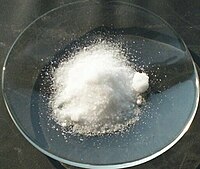Saltpetre
 |
|||
|
|
|||
| Names | |||
|---|---|---|---|
|
IUPAC name
Potassium nitrate
|
|||
| Other names
Saltpetre
Nitrate of potash |
|||
| Identifiers | |||
|
7757-79-1 |
|||
| 3D model (Jmol) | Interactive image | ||
| ChEMBL |
ChEMBL1644029 |
||
| ChemSpider |
22843 |
||
| ECHA InfoCard | 100.028.926 | ||
| EC Number | 231-818-8 | ||
| E number | E252 (preservatives) | ||
| KEGG |
D02051 |
||
| PubChem | 24434 | ||
| RTECS number | TT3700000 | ||
| UNII |
RU45X2JN0Z |
||
| UN number | 1486 | ||
|
|||
|
|||
| Properties | |||
| KNO3 | |||
| Molar mass | 101.1032 g/mol | ||
| Appearance | white solid | ||
| Odor | odorless | ||
| Density | 2.109 g/cm3 (16 °C) | ||
| Melting point | 334 °C (633 °F; 607 K) | ||
| Boiling point | decomposes at 400 °C | ||
| 133 g/L (0 °C) 316 g/L (20 °C) 2460 g/L (100 °C) |
|||
| Solubility | slightly soluble in ethanol soluble in glycerol, ammonia |
||
| Basicity (pKb) | 15.3 | ||
| −33.7·10−6 cm3/mol | |||
|
Refractive index (nD)
|
1.335, 1.5056, 1.5604 | ||
| Structure | |||
| Orthorhombic, Aragonite | |||
| Thermochemistry | |||
| 95.06 J/mol K | |||
|
Std enthalpy of
formation (ΔfH |
-494.00 kJ/mol | ||
| Hazards | |||
| Main hazards | Oxidant, Harmful if swallowed, Inhaled, or absorbed on skin. Causes Irritation to Skin and Eye area. | ||
| Safety data sheet |
See: data page ICSC 0184 |
||
|
EU classification (DSD)
|
Oxidant (O) | ||
| R-phrases | R8 R22 R36 R37 R38 | ||
| S-phrases | S7 S16 S17 S26 S36 S41 | ||
| NFPA 704 | |||
| Flash point | Non-flammable | ||
| Lethal dose or concentration (LD, LC): | |||
|
LD50 (median dose)
|
1901 mg/kg (oral, rabbit) 3750 mg/kg (oral, rat) |
||
| Related compounds | |||
|
Other anions
|
Potassium nitrite | ||
|
Other cations
|
Lithium nitrate Sodium nitrate Rubidium nitrate Caesium nitrate |
||
|
Related compounds
|
Potassium sulfate Potassium chloride |
||
| Supplementary data page | |||
|
Refractive index (n), Dielectric constant (εr), etc. |
|||
|
Thermodynamic
data |
Phase behaviour solid–liquid–gas |
||
| UV, IR, NMR, MS | |||
|
Except where otherwise noted, data are given for materials in their standard state (at 25 °C [77 °F], 100 kPa).
|
|||
|
|
|||
| Infobox references | |||
Potassium nitrate is a chemical compound with the chemical formula KNO3. It is an ionic salt of potassium ions K+ and nitrate ions NO3−, and is therefore an alkali metal nitrate.
It occurs as a mineral niter and is a natural solid source of nitrogen. Potassium nitrate is one of several nitrogen-containing compounds collectively referred to as saltpeter or saltpetre.
Major uses of potassium nitrate are in fertilizers, tree stump removal, rocket propellants and fireworks. It is one of the major constituents of gunpowder (blackpowder) and has been used since the Middle Ages as a food preservative.
Potassium nitrate, because of its early and global use and production, has many names.
The Greeks used the term nitron, which was Latinised to nitrum or nitrium, while earlier Hebrews and Egyptians used words with the consonants n-t-r, which leads some to speculate that the Latin term is closer to the original than the Greek term. Middle English styled it nitre. Old French had niter. By the 15th century, Europeans referred to it as saltpeter and later as nitrate of potash, as the chemistry of the compound was more fully understood.
The Arabs called it "Chinese snow" (Arabic: ثلج الصين thalj al-ṣīn). It was called "Chinese salt" by the Iranians/Persians or "salt from Chinese salt marshes" (Persian: نمک شوره چيني namak shūra chīnī).
...
Wikipedia



